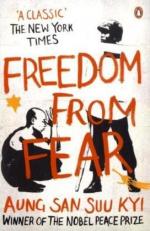
|
| Name: _________________________ | Period: ___________________ |
This quiz consists of 5 multiple choice and 5 short answer questions through Part 2: Section 9.
Multiple Choice Questions
1. For Aung San Suu Kyi, how will the forces that produce inequities be conquered?
(a) By an uprising of the people.
(b) Through an international tribunal.
(c) Out of a spiritual revolution.
(d) Through non-violent resistance.
2. Suu Kyi states in her speech at the Shwedagon Pagoda in Rangoon on 26 August 1988 that people should so which of the following?
(a) To stage nationwide peaceful demonstrations to "draw attention to the unrest among the people."
(b) Create a solidarity to "resist the tyrrany."
(c) Strive forward together using "disciplined and peaceful means."
(d) Be courageous and "weather the storms of change."
3. According to Aung San Suu Kyi, what corrupts individuals?
(a) Greed.
(b) Money.
(c) Fear.
(d) Power.
4. What war brought Burma under British rule?
(a) The Opium War.
(b) The Five Year War.
(c) The Perak War.
(d) The Anglo-Burmese War.
5. Who published Aung San Suu Kyi's work that examines the themes in Burmese literature and political thought?
(a) Tokyo University.
(b) Bangkok University.
(c) Seoul National University.
(d) University of Mumbai.
Short Answer Questions
1. Which country had formed a similar committee that is being proposed in "The Formation of a People's Committee"?
2. According to Aung San Suu Kyi, what is part of the unceasing human endeavor to prove?
3. What event brought Aung San's name into prominence in the Burmese nationalism movement?
4. Where was the Burma Independence Army (BIA) formed?
5. What was the Freedom Bloc?
|
This section contains 317 words (approx. 2 pages at 300 words per page) |

|




